
The Cessna 208 Caravan is a utility aircraft produced by Cessna. The project was commenced on November 20, 1981, and the prototype first flew on December 9, 1982. The production model was certified by the FAA in October 1984 and its Cargomaster freighter variant was developed for FedEx. The 4 ft (1.2 m) longer 208B Super Cargomaster first flew in 1986 and was developed into the passenger 208B Grand Caravan.
The FF-1080 is an aircraft design by Utilicraft Aerospace Industries of Albuquerque, New Mexico, USA, for a twin turboprop aircraft fitted to carry LD3 aircraft cargo containers between large airports and smaller airports.

The AEA Explorer is a large single-engine utility aircraft.

The Cessna 441 Conquest II is the first turboprop powered aircraft designed by Cessna and was meant to fill the gap between their jets and piston-engined aircraft. It was developed in November 1974, with the first aircraft delivered in September 1977. It is a pressurized, 8–9 passenger turbine development of the Cessna 404 Titan.

Evektor-Aerotechnik is a Czech aircraft manufacturer based in Kunovice, Czech Republic. The company produces a range of light sport aircraft, training, advanced ultralight aircraft and electric aircraft.

The Let L-410 Turbolet is a twin-engine short-range transport aircraft designed and produced by the Czech aircraft manufacturer Let Kunovice.

The PAC P-750 XSTOL, is a utility aircraft of conventional all-metal low-wing monoplane design, with fixed tricycle undercarriage. Combining the engine and wings of the PAC Cresco with a new larger fuselage and modified tail, all versions to date have been powered by a 750 hp (560 kW) Pratt & Whitney Canada PT6 turboprop. It is designed and manufactured in Hamilton, New Zealand, by Pacific Aerospace Limited.

The Beechcraft Model 99 is a civilian aircraft produced by Beechcraft. It is also known as the Beech 99 Airliner and the Commuter 99. The 99 is a twin-engine, unpressurized, 15 to 17 passenger seat turboprop aircraft, derived from the earlier Beechcraft King Air and Queen Air. It uses the wings of the Queen Air, the engines and nacelles of the King Air, and sub-systems from both, with a specifically designed nose structure.

The Beriev Be-30 is a Russian regional airliner and utility transport aircraft designed by the Beriev Design Bureau. It was developed specifically for Aeroflot local service routes using short, grass airstrips. It was also designed to be used in the light transport, aerial survey and air ambulance roles. It competed against the Antonov An-28 and the Czechoslovakian LET-410.
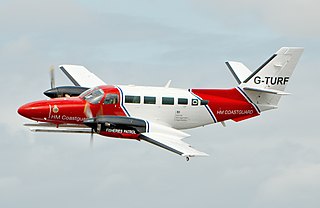
The Reims-Cessna F406 Caravan II is a turboprop twin engine utility aircraft manufactured and designed by Reims Aviation in cooperation with Cessna.
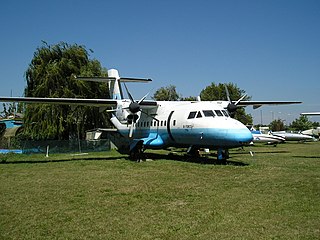
The Let L-610 is a prototype aircraft for the Czech civil aircraft manufacturer Let Kunovice made in 1988–1997.

The Aérospatiale N 262 is a French twin-turboprop high-wing airliner built first by Nord Aviation. The aircraft was also known as the Nord 262.

The Air Tractor AT-500 is a family of agricultural aircraft that first flew in the United States on 25 April 1986, manufactured by Air Tractor Inc. Of monoplane low-wing, taildragger configuration, they carry a chemical hopper between the engine firewall and the cockpit. Compared with their predecessor, the AT-500 family featured a wingspan increase of 50 ft, and an additional fuselage stretch of 22 in (56 cm), allowing for a larger chemical hopper. Almost all variants offer a widened "buddy" seat or a tandem seat for a passenger, observer, or loader; trainer aircraft with full dual controls have also been offered.
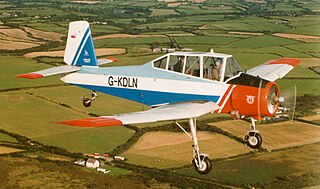
The Zlin Z-37 Čmelák, also known as LET Z-37 Čmelák is an agricultural aircraft which was manufactured in Czechoslovakia. It is powered by a Soviet-built Ivchenko reciprocating engine. The aircraft is used mainly as a cropduster.

The PZL-106 Kruk is a Polish agricultural aircraft designed and built by WSK PZL Warszawa-Okęcie.

The Beriev Be-112 is a proposed amphibian aircraft with two propeller engines, projected to carry 27 passengers. The Beriev firm lacks a production amphibian aircraft in this size.
The Smith X-99 Prop-Jet was a six-seat turboprop powered business aircraft designed in the United States in the 1980s. Only one was built.
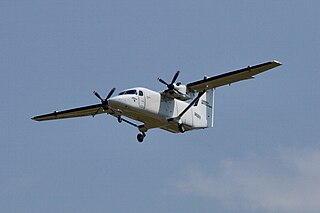
The Cessna 408 SkyCourier is an American utility aircraft designed and built by the Cessna division of Textron Aviation. It was launched on November 28, 2017, with an order for 50 from FedEx Express, with the aircraft designed for the needs of its FedEx Feeder service. It made its first flight on May 17, 2020, and was type certified on March 11, 2022. FedEx took delivery of the first production model on May 9, 2022.
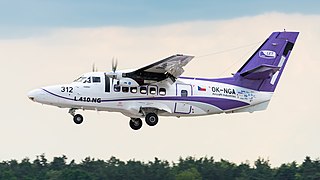
Aircraft Industries L 410 NG is a twin-engine 19-seat aircraft manufactured by the Czech company, Aircraft Industries. The aircraft is an upgraded version of the Let L 410 UVP-E20. The first flight took place on 29 July 2015. Serial production of the L 410 NG began in March 2018.
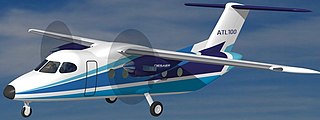
The Desaer ATL-100 is a twin-turboprop, high-wing, utility aircraft under development by Desaer in Brazil and by CEiiA in Portugal.


















